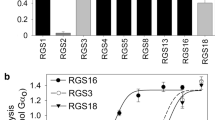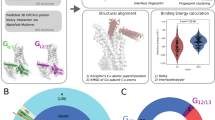Abstract
The RGS proteins act as GTPase activating proteins and therefore regulate the lifespan of the active G alpha-GTP by accelerating the GTP hydrolysis. Modulatory residues in the RGS protein are present at the periphery of the RGS domain-G protein interface which is essential to fine-tune the G protein recognition and interaction. The docking energies of the mutant complex and the native complex were compared to see the effects of the mutations in the Modulatory regions. Mutations of Modulatory residues in high-activity RGS proteins lead to loss of function, whereas multiple mutations in the low-activity RGS proteins in critical Modulatory positions lead to complete gain of function. In the RGS proteins the Significant and Conserved core residues with peripheral Modulatory residues selectively optimize G protein recognition and inactivation. The flexibility of the structures of the mutant complexes were seen to be higher and the accessible surface area for the complexes increased after the mutations in the Modulatory residues. Through this approach we analyzed the interaction specificity among the RGS and the G alpha protein, the approach can also be applied to other protein families to find the residues which along with the core binding domain, fine tune the protein recognition and are crucial in the loss or gain of function.
Similar content being viewed by others
References
Berthebaud, M., Riviére, C., Jarrier, P., Foudi, A., Zhang, Y., Compagno, D., Galy, A., Vainchenker, W., Louache, F. 2005. RGS16 is a negative regulator of SDF-1-CXCR4 signaling in megakaryocytes. Institute National de la Santé et de la Recherche Médicale (INSERM) U 362, Institute Gustave Roussy, Villejuif, France. Blood 106, 2962–2968
Bessant, D., Payne, A.M., Snow, B.E., Antinolo, G., Mehdi, S.Q., Bird, A.C., Siderovski, D.P., Bhattacharya, S.S. 2000. Importance of the autosomal recessive retinitis pigmentosa locus on 1q31–q32.1 (RP12) and mutation analysis of the candidate gene RGS16 (RGS-r). J Med Genet 37, 384–387.
Bockaert, J., Pin, J.P. 1999. Hall, Molecular tinkering of G protein-coupled receptors: An evolutionary success. EMBO J 18, 1723–1729.
Bourne, H.R., Sanders, D.A., Mccormick, F. 1990. The GTPase superfamily: A conserved switch for diverse cell functions. Nature 348, 125–132.
Chatterjee, T.K., Fisher, R.A. 2000. Cytoplasmic, nuclear, and golgi localization of RGS proteins. Evidence for N-terminal and RGS domain sequences as intracellular targeting motifs. J Biol Chem 275, 24013–24021.
Cifelli, C., Rose, R.A., Zhang, H., Voigtlaender-Bolz, J., Bolz, S., Backx, P.H., Heximer, S.P. 2008. RGS4 regulates parasympathetic signaling and heart rate control in the sinoatrial node. Circ Res 103, 527–535.
Comeau, S.R., Gatchell, D.W., Vajda, S., Camacho, C.J. 2004a. ClusPro: An automated docking and discrimination method for the prediction of protein complexes. Bioinformatics 20, 45–50.
Comeau, S.R., Gatchell, D.W., Vajda, S., Camacho, C.J. 2004b. ClusPro: A fully automated algorithm for protein-protein docking. Nucleic Acids Res 32, W96–W99.
De Vries, L., Farquhar, M.G. 1999. RGS proteins: more than just GAPs for heterotrimeric G proteins. Trends Cell Biol 9, 138–144.
De Vries, L., Zheng, B., Fischer, T., Elenko, E. and Farquhar, M.G. 2000. The regulator of G protein signaling family. Annu Rev Pharmacol Toxicol 40, 235–271.
Dohlman, H.G., Thorner, J. 1997. RGS proteins and signaling by heterotrimeric G proteins. J Biol Chem 272, 3871–3874.
Garzón, J., Rodríguez-Muñoz, M., López-Fando, A., Sáanchez-Bláazquez, P. 2005. The RGSZ2 protein exists in a complex with µ-opioid receptors and regulates the desensitizing capacity of Gz. Neuropsychopharmacol 30, 1632–1648.
Hall, R.A., Premont, R.T., Lefkowitz, R.J. 1999. Heptahelical receptor signaling: Beyond the G protein paradigm. J Cell Biol 145, 927–932.
Hamm, H.E. 1998. The many faces of G protein signaling. J Biol Chem 273, 669–672.
Hepler, J.R. 2003. RGS protein and G protein interactions: A little help from their friends. Mol Pharmacol 64, 547–549.
Hepler, J.R., Gilman, A.G. 1992. G proteins. Biochem Sci 17, 383–387.
Hollinger, S., Hepler, J.R. 2002. Cellular regulation of RGS proteins: Modulators and integrators of G protein signaling. Pharmacol Rev 54, 527–559.
Koelle, M.R. 1997. A new family of G-protein regulators - the RGS proteins. Curr opin Cell Biol 9, 143–147.
Kosloff, M., Travis, A.M., Bosch, D.E., Siderovski, D.P., Arshavsky, V.P. 2011. Integrating energy calculations with functional assays to decipher the specificity of G protein-RGS protein interactions. Nat Struct Mol Biol 18, 846–853.
Kozakov, D., Brenke, R., Comeau, S.R., Vajda, S. 2006. PIPER: An FFT-based protein docking program with pairwise potentials. Proteins 65, 392–406.
Kozakov, D., Hall, D.R., Beglov, D., Brenke, R., Comeau, S.R., Shen, Y., Li, K., Zheng, J., Vakili, P., Paschalidis, I.C., Vajda, S. 2010.Achieving reliability and high accuracy in automated protein docking: Cluspro, PIPER, SDU, and stability analysis in CAPRI rounds 13–19. Proteins: Proteins: Struct, Funct, Bioinf 78, 3124–3130.
Liang, G., Bansal, G., Xie, Z., Druey, K.M. 2009. RGS16 inhibits breast cancer cell growth by mitigating phosphatidylinositol 3-kinase signaling. J Biol Chem 284, 21719–21727.
Lippert, E., Yowe, D.L., Gonzalo, J.A., Justice, J.P., Webster, J.M., Fedyk, E.R., Hodge, M., Miller, C., Gutierrez-Ramos, J.C., Borrego, F., Keane-Myers, A., Druey, K.M. 2003. Role of regulator of G protein signaling 16 in inflammation-induced T lymphocyte migration and activation. J Immunol 17, 1542–1555.
Mao, H., Zhao, Q., Daigle, M., Ghahremani, M.H., Chidiac, P., Albert, P.R. 2004. RGS17/RGSZ2, a novel regulator of Gi/o, Gz, and Gq signaling. J Biol Chem 279, 26314–26322.
Mirnics, K., Middleton, F.A., Stanwood, G.D., Lewis, D.A., Levitt, P. Disease-specific changes in regulator of G-protein signaling 4 (RGS4) expression in schizophrenia. Mol Psychiatry 6, 292–301.
Mittmann, C., Chung, C.H., Höppner, G., Michalek, C., Nose, M., Schüler, C., Schuh, A., Eschenhagen, T., Weil, J., Pieske, B., Hirt, S., Wieland, T. 2002. Expression of ten RGS proteins in human myocardium: Functional characterization of an upregulation of RGS4 in heart failure. Cardiovasc Res 55, 778–786.
Negi, S.S., Schein C.H., Oezguen, N., Power, T.D., Braun, W. 2007. InterProSurf: A web server for predicting interacting sites on protein surfaces. Struct Bioinf 23, 3397–3399.
Purohit, R., Rajasekaran, R., Sudandiradoss, C., George Priya Doss C., Ramanathan, K., Sethumadhavan, R. 2008. Studies on flexibility and binding affinity of Asp25 of HIV-1 protease mutants. Int J Biol Macromol 42, 386–391.
Purohit, R., Rajendran, V., Sethumadhavan, R. 2011a. Relationship between mutation of serine residue at 315th position in M. tuberculosis catalase-peroxidase enzyme and Isoniazid susceptibility: An in silico analysis. J Mol Model 17, 869–877.
Purohit, R., Rajendran, V., Sethumadhavan, R. 2011b. Studies on adaptability of binding residues and flap region of TMC-114 resistance HIV-1 protease mutants. J Biomol Struct Dyn 29, 137–152.
Purohit, R., Sethumadhavan, R. 2009. Structural basis for the resilience of darunavir (TMC114) resistance major flap mutations of HIV-1 protease. Interdiscip Sci Comput Life Sci 1, 320–328.
Rajendran, V., Purohit, P., Sethumadhavan, R. 2012. In silico investigation of molecular mechanism of laminopathy cause by a point mutation (R482W) in lamin A/C protein. Amino Acids 43, 603–615.
Rogers, J.H., Tsirka, A., Kovacs, A., Blumer, K.J., Dorn, G.W. 2nd, Muslin, A.J. 2001. RGS4 reduces contractile dysfunction and hypertrophic gene induction in Galpha q over expressing mice. J Mol Cell Cardiol 33, 209–218.
Ross, E.M., Wilkie, T.M. 2000. GTPase activating protein for heterotrimeric G proteins, regulators of G protein signaling (RGS) and RGS-like proteins. Annu Rev Biochem 69, 795–827.
Roy, A., Kucukural, A., Zhang, Y. 2010. I-TASSER: A unified platform for automated protein structure and function prediction. Nature Protocols 5, 725–738.
Soundararajan, M., Willard, F.S., Kimple, A.J., Turnbull, A.P., Ball, L.J., Schoch, G.A., Gileadi, C., Fedorov, O.Y., Dowler, E.F., Higman, V.A., Hutsell, S.Q., Sundstrom, M., Doyle, D.A., Siderovski, D.P. 2008. Structural diversity in the RGS domain and its interaction with heterotrimeric G protein alphasubunits. Proc Natl Acad Sci USA 105, 6457–6462.
Srinivasa, S.P., Bernstein, L.S., Blumer, K.J., Linder, M.E. 1998. Plasma membrane localization is required for RGS4 function in Saccharomyces cerevisiae. Proc Natl Acad Sci USA 12, 5584–5589.
Suhre, K., Sanejouand, Y. 2004. Elnemo: A normal mode web server for protein movement analysis and the generation of templates for molecular replacement. Nucl Acid Res 32, W610–W614.
Tamirisa, P., Blumer, K.J., Muslin, A.J. 1999. RGS4 inhibits G-protein signaling in cardiomyocytes. Circulation 99, 441–447.
Tesmer, J.J.G., Berman, D.M., Gilman, A.G., Sprang, S.R. 1997. Structure of RGS4 bound to ALF4-activated G (iq 1): Stabilization of the transition state for GTP hydrolysis. Cell 89, 251–261.
Watson, N., Linder, M.E., Druey, K.M., Kehrl, J.H., Blumer, K.J. 1996. RGS family members: GTPaseactivating proteins for heterotrimeric G-protein alphasubunits. Nature 383, 172–175.
Wieland, T. Mittmann, C. 2003. Regulators of Gprotein signaling: Multifunctional proteins with impact on signaling in the cardiovascular system. Pharmacol Ther 97, 95–115.
Willard, L., Ranjan, A., Zhang, H., Monzavi, H., Boyko, R.F., Sykes, B.D., Wishart, D.S. 2003. VADAR: A web server for quantitative evaluation of protein structure quality. Nucleic Acids Res 31, 3316–3319.
Zhong, H., Neubig, R.R. 2001. Regulator of G protein signaling proteins: Novel multifunctional drug targets. J Pharmacol and Exp Ther 297, 837–845.
Author information
Authors and Affiliations
Corresponding author
Rights and permissions
About this article
Cite this article
Gulati, G., Gaonkar, K.S., Kamraj, B. et al. Structure based energy calculation to determine the regulation of G protein signalling by RGS and RGS-G protein interaction specificity. Interdiscip Sci Comput Life Sci 4, 173–182 (2012). https://doi.org/10.1007/s12539-012-0130-0
Received:
Revised:
Accepted:
Published:
Issue Date:
DOI: https://doi.org/10.1007/s12539-012-0130-0




